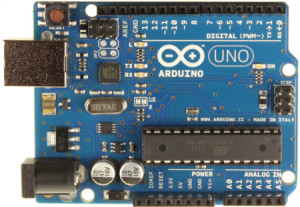Speed Calculations & Component Modification
By Matthew Clegg, Computer and Control Systems
In order to tackle the initial calculated speed requirement of the rover project, we would need a starting point for Spiderbot. For this reason, I decided to make a calculation to determine the speed that the servo motors on Spiderbot’s legs would need to move in order for the entire robot to match the rover speed.
To try to estimate a possible speed for Spiderbot, I first calculated a velocity based on the speed of the servo motors. A servo’s rated speed is how fast, in seconds, the arm can move 60 degrees. To apply this to Spiderbot, I took into account the motion of the bot in a tripod gait, which is the most efficient walking pattern.
Assuming the length of the femur to be 5” (the value assigned to the initial Spiderbot design done by Simon Abatay in manufacturing) and the femur moving forward at a 60 degree angle (the speed rating provided by servo motor specification sheets), then using trigonometry,
In SI units, each sweep of the leg will cover 0.109 meters. In the tripod gait, the leg will move up 30 degrees, forward 60 degrees, then back down 30. Knowing the sweep of the leg is 0.109meters, he came up with a formula to find the time in seconds
Dividing this time by 2 to account for both motions of the gait results in
The total degree movement of a leg is 30, 60 and 30 degrees. He divided 0.26s by two to find out how fast the servo moves 60 degrees to reach a speed of
These calculated values are our project’s starting point. They are subject to change once more progress is developed with the rover project and more concrete details are obtained.
Lastly, it has come to our attention that using both the Mega ADK microcontroller and Adafruit breakout boards (as stated in a previous blog post for this project) would be redundant. The Mega ADK was considered because it could accommodate the amount of servos we would need to construct Spiderbot. Breakout boards were considered because it was the route that both spider projects took last semester in terms of design. We decided to instead use the breakout boards along with an Arduino Uno R3 microcontroller since we already have one in our possession, so the decision was mostly based out of convenience. Using these two components together will essentially be the same as using a single Mega ADK. An image of our newly chosen component can be seen below:

(Image found at: http://arduino.cc/en/Main/arduinoBoardUno)

